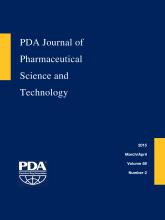Abstract
Using bottom-mounted mixers, particularly those that are magnetically driven, is becoming increasingly common during the mixing process in pharmaceutical and biotechnology manufacturing because of their associated low risk of contamination, ease of use, and ability to accommodate low minimum mixing volumes. Despite these benefits, the impact of bottom-mounted mixers on biologic drug product is not yet fully understood and is scarcely reported. This study evaluated four bottom-mounted mixers to assess their impact on monoclonal antibody formulations. Changes in product quality (size variants, particles, and turbidity) and impact on process performance (sterile filtration) were evaluated after mixing. The results suggested that mixers that are designed to function with no contact between the impeller and the drive unit are the most favorable and gentle to monoclonal antibody molecules. Designs with contact or a narrow clearance tended to shear and grind the protein and resulted in high particle count in the liquid, which would subsequently foul a filter membrane during sterile filtration using a 0.22 μm pore size filter. Despite particle formation, increases in turbidity of the protein solution and protein aggregation/fragmentation were not detected. Further particle analysis indicated particles in the range of 0.2–2 μm are responsible for filter fouling. A small-scale screening model was developed using two types of magnetic stir bars mimicking the presence or absence of contact between the impeller and drive unit in the bottom-mounted mixers. The model is capable of differentiating the sensitivity of monoclonal antibody formulations to bottom-mounted mixers with a small sample size. This study fills an important gap in understanding a critical bioprocess unit operation.
LAY ABSTRACT: Mixing is an important unit operation in drug product manufacturing for compounding (dilution, pooling, homogenization, etc.). The current trend in adopting disposable bottom-mounted mixers has raised concerns about their impact on drug product quality and process performance. However, investigations into the effects of their use for biopharmaceutical products, particularly monoclonal antibody formulations, are rarely published. The purpose of this study is three-fold: (1) to understand the impact of bottom-mounted disposable mixer design on drug product quality and process performance, (2) to identify the mixing mechanism that is most gentle to protein particle formation, (3) to apply the learning to practical mixing operations using bottom-mounted mixers. The outcomes of this study will benefit scientists and engineers who develop biologic product manufacturing process by providing a better understanding of mixing principles and challenges.
- Bottom-mounted mixing
- Monoclonal antibody
- Levitation mixer
- Magnetic mixer
- Disposables
- Filter fouling
- Particle formation
- © PDA, Inc. 2015
PDA members receive access to all articles published in the current year and previous volume year. Institutional subscribers received access to all content. Log in below to receive access to this article if you are either of these.
If you are neither or you are a PDA member trying to access an article outside of your membership license, then you must purchase access to this article (below). If you do not have a username or password for JPST, you will be required to create an account prior to purchasing.
Full issue PDFs are for PDA members only.
Note to pda.org users
The PDA and PDA bookstore websites (www.pda.org and www.pda.org/bookstore) are separate websites from the PDA JPST website. When you first join PDA, your initial UserID and Password are sent to HighWirePress to create your PDA JPST account. Subsequent UserrID and Password changes required at the PDA websites will not pass on to PDA JPST and vice versa. If you forget your PDA JPST UserID and/or Password, you can request help to retrieve UserID and reset Password below.






